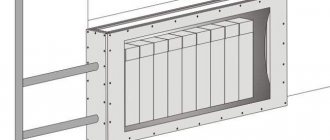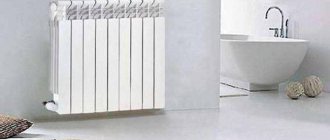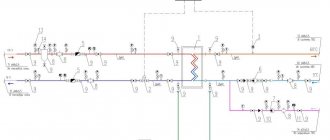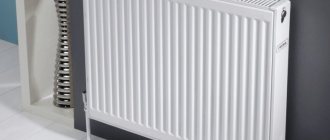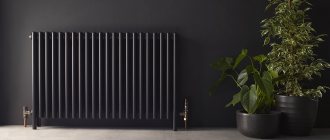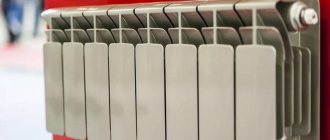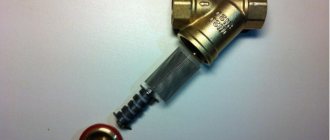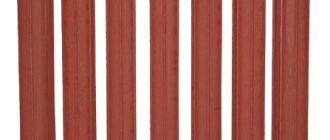An accordion battery is a heating device that consists of rounded pipes with fins. The entire structure is made of steel and has excellent strength and resistance to the external environment. Such radiators have been known since the times of the USSR - they were often installed in residential and industrial premises, state enterprises and public places. The device has a simple structure, has a long service life and performs its functions perfectly. The structure can be quickly manufactured using welding or a pipe bender. Its main advantage is the absence of recesses in which air and dirt are retained. This structure ensured ease of use and low cost of the device.
Accordion radiator Source utepleniedoma.com
What are plate radiators
Such accordion-type batteries are one of the types of convector devices. The device is distinguished by a significant size of the heat exchange part and a small number of pipes. The equipment works as follows:
- The coolant is passed through the radiator pipes, while the high pressure in the system ensures the transfer of thermal energy to the device;
- The metal plates on the pipes quickly heat up under the influence of the resulting heat;
- The hot plates, in turn, heat the air that is between them;
- The heated air becomes lighter and rises to the upper part of the room;
- The displaced cold air falls down, where it is gradually heated by the radiator.
Wall with a battery Source uborka.com.ua
The main feature of accordion batteries is their operation as a convector. The devices influence air circulation and heat it, but at the same time their temperature is insufficient to be exposed to thermal radiation.
Efficient operation of the radiator is achieved through a combination of high coolant temperature, high pressure in the system and narrow pipes. As a result, the plates quickly heat up and circulate air in the room.
If you need to increase heat transfer in the battery, you can use metal corrugation. This design is attached in the form of a protective panel and increases the size of the heating device. The amount of air passing through the device also increases, and convection becomes more efficient.
The old-style accordion battery heated the room using natural air convection. This was the disadvantage of the product, which was especially evident in large apartments. The temperature difference reached high values, it was hot at the top, but the floor remained cold. To get rid of this problem, over time they began to use a built-in fan. New plate-type radiators operate on electricity, performing artificial air circulation. As a result, the room warms up more evenly and cold areas disappear.
White radiator on the wall Source prom-stanki.ru
Determination of thermal power of plate heating devices
The formula for determining the thermal power that a steel plate heating radiator can produce, and a real example of calculating this parameter, are given below. To calculate the power of the device, it is enough to know the heat loss coefficient of the heated room, the area of the room and its total volume. The passport of any radiator indicates its calculated power at a hot water temperature in the system of 600C. The attached documentation also contains recommendations for the heated area for a specific radiator model.
The thermal output (power) of heating devices depends on the length of the body and the number of plates. The standard height of radiators is 200 mm, the number of plates varies. For example, heat transfer for a radiator with one tube and a body length of 600 mm will be equal to ≈ 347 W. When the length is increased to 3000 mm, the heat transfer will increase to 1730 W. But with the same body length (3000 mm) and an increase in pipes to 4, heat transfer there will already be 4179 W, and with a body length of 1000 mm, four tubes with coolant will give 1393 W of power. Therefore, which radiator is best to buy for a specific room is determined based on the following requirements:
- To heat 1 m2 of a room with a ceiling height of 3 m, you need to spend 100 W;
- For a room with an area of 16 m2, the radiator must have a thermal power of 1600 W, provided that the room has no more than one window, the room is not corner and the ceiling has a height of no more than 3 m. For other initial conditions, correction factors Kp are introduced:
- For two windows Kp = 1.8 / 1600 x 1.8 = 2880 W;
- For a corner room Kp = 1.8 / 2880 x 1.8 = 5184 W;
- For a ceiling 2.65 meters high Kp = 2.65 / 3.0 = 0.88 / 5148 W x 0.88 = 4547 W;
- For PVC windows Kp = 0.8 / 4547 W x 3637 W.
A standard metal-plastic window is 1400 mm wide, so to fully block cold air flows, a radiator of four sections 1400 mm long, with a power of 1950 W, is installed underneath it.
Power table
The heating radiator works like this:
- Under pressure or gravity, the coolant moves through the battery tubes, heating them;
- The tubes heat the plates welded to them, and together the structure heats the air between the radiator elements, which rises up to the ceiling of the room;
- Cold air masses, under the pressure of warm air, fall down to the radiator, where they heat up;
- Then the cycle repeats.
That is, in any radiators, the room is heated with coolant due to air convection.
Plate radiators have one distinctive feature: due to the small diameter of the coil, an insufficient amount of coolant passes through them per unit time to heat the room, so it is necessary either to keep the temperature in the boiler constantly high, or to install radiators with a large number of plates (sections).
High power radiators
To increase the efficiency of a plate heating battery, a metal corrugation is placed on its body, which at the same time serves as a protective casing. The corrugated surface increases the heat transfer area, which leads to an increase in the volume of warm air.
In older models of plate radiators, convection (movement) of air occurred naturally - due to the movement of warm and cold air flows. New models have built-in electric fans, and therefore you only need to increase the coolant temperature without increasing the radiator area in order to achieve the maximum possible heat transfer from the device. That is, in modern models artificial (forced) convection occurs.
Plate radiator with fan
Today, manufacturers offer to buy radiators made from the following materials and different designs:
- The steel radiator has both tubes and steel plates. Although its strength is high, heat transfer is characterized by inertia;
- The copper radiator has increased power and heat transfer. All this is accompanied by the high cost of the device, but if you decide to buy it, choose a copper coil and steel plates: it will be cheaper and will not affect the quality and durability of the radiator;
- An aluminum radiator is the cheapest model with minimal heat transfer inertia, but it cools down as quickly as it heats up. The body is not as durable as the first two models, and the metal itself is susceptible to corrosion due to poor-quality coolant. Therefore, it is better not to install such devices in central heating.
Radiators made of different alloys
Main types of heating devices
The following types of batteries are most often used in everyday life:
- Sectional. They are made from aluminum or several different metals. These structures consist of parts connected to each other using steel nipples. They look attractive and provide good air circulation. Such devices may include several sections in one battery.
Sectional battery Source eurosantehnik.ru
- Tubular. These designs are not widely used. Among their advantages are a long heat transfer time and an aesthetic appearance of the device.
Tubular battery Source stroy-podskazka.ru
- Panel. One of the most effective devices for home use. Pros: large working area, good level of convection, varied design and wide range of equipment. Such a battery can be selected for almost any room; the sizes of radiators differ markedly from each other. Among the disadvantages are high prices for products, as well as low operating pressure.
Panel battery Source gopb.ru
- Lamellar. They are characterized by a high level of pressure, have good heat transfer and provide effective air circulation. These devices can be used as in-floor convectors; they are available in a variety of shapes and designs.
Plate battery Source gidroguru.com
Steel flat heating radiators
A study of all models of heating devices existing on the market leads to the following conclusion: only a steel flat heating radiator meets the standards of panel radiators. Therefore, it is he who deserves closer consideration. Thanks to the use of special manufacturing technology, products of this type are given a small thickness and stylish appearance.
Features of flat radiators:
- For production, stamped steel sheet is used.
- The base is a solid sheet with a good level of recess.
- The small surface area results in reduced heat dissipation from the battery.
- The heat transfer can be increased by using not a sectional, but a flat, continuous design of the device.
- As follows from the previous two points, heating a room requires less coolant and energy.
For those users who require increased heat transfer, additional elements are provided in the form of convection fins. To install them, spot welding is used over the entire area of the battery. Most often, these ribs are given a trapezoidal shape.
Battery materials
Plate radiators can be made of various materials, which affects the rate of heat transfer and other performance characteristics. Modern devices are most often made on the basis of:
- Become. The plates and pipes of the device are made from this material. The radiator turns out to be very durable, it can easily withstand even strong water hammer. The disadvantage is the slow rate of heat exchange.
Steel radiator Source utepleniedoma.com
- Copper. The all-copper accordion battery has good power and heat transfer rate. Excellent characteristics are overshadowed by the high price of the finished product, so a combination of materials is most often used. Copper tubes are equipped with cheaper steel or other metal plates. As a result, the final cost of the device can be significantly reduced.
- Aluminum. This is a relatively cheap solution that has a high heat transfer rate. The disadvantage of this option is insufficient strength, so it is not used in central heating systems. It makes sense to combine aluminum plates with copper pipes to obtain stable equipment.
Aluminum radiator Source gidroguru.com
Accordion radiators of different generations differ in the number of working circuits and panels for convection. If there is a single circuit and a set of plates, the battery is designated class 11. There is also a class 22, which indicates double the number of these parts. If two sets of plates are combined with a common coil, such a product will belong to class 21.
The dimensions of plate batteries can vary significantly, which makes it easy to select a device for a specific room. The appliances come in a variety of designs in the market, so users can purchase a suitable option for each style.
What are radiator screens made of?
Grids and boxes are made from almost any material. The main condition is their resistance to high temperatures. The exception is plastic products, since to increase strength the box will have to be made too wide. As a result, the radiator will dissipate heat worse and its efficiency will decrease. Other types of materials are quite suitable for making screens. The most common among them:
- Wood. Its appearance and environmental friendliness make wood products one of the best options for casings.
Wooden screen Source bykdyb.ru
- MDF boards. They are resistant to temperature fluctuations and tolerate changes in humidity levels in the house.
Battery screen made of MDF board Source craftsman.in.ua
- Glass. Heat passes through it well, and the product also gets a beautiful exterior that fits perfectly into almost any room style.
Glass screen Source otoplenie-expert.com
- Metal. Its high thermal conductivity promotes better distribution of air flows and increases the working surface of the device. Steel and copper casings can be used for a long time; they do not deform or deteriorate under the influence of temperature changes. For this reason, such materials are especially often used in combination with cast iron radiators.
Metal screen Source craftsman.in.ua
Steel plate batteries
During the Soviet Union, cast iron radiators were common, which had the appearance of an accordion. Many people confuse such devices with the plate type, which was made primarily of steel. It can still be found in the hallways of old houses and in old government buildings.
The basis of the devices is a tube with plates located on it. The latter perform the function of heat exchange due to the large total surface area. Modern products have increased efficiency due to improved design.
The advantage that distinguishes the steel accordion battery from other types is its ability to withstand pressure of 20 atmospheres. The coolant is passed through the pipes under high pressure, which causes their surface to quickly heat up and transfer thermal energy to the plates. The surface of the latter comes into contact with the air, as a result of which it also becomes warmer.
Such devices have become popular due to their low cost. A modest exterior and rapid surface contamination are considered disadvantages that can be eliminated with the help of special screens. When open, such products are often installed in public places and enterprises, and in residential buildings protective covers are installed on them.
Steel radiator: accordion or plate does not go out of use in our country, since its advantages outweigh its disadvantages. There are many options for such devices, some of them are quite suitable even for use in central heating systems. If necessary, you can purchase exactly the variety that is most effective in a particular room.
What parameters should you use to choose radiators for an apartment?
Now, knowing the weak points of central heating, you can already imagine what requirements good batteries must meet. Let's list them.
1. For radiators, the pressure declared by the manufacturer must exceed the pressure (both the working pressure and one and a half times the test pressure) in the heating system. Let's look at the numbers as an example. In five-story buildings with an old layout, this parameter is no more than 5 - 8 atmospheres. Modern multi-storey buildings are heated under pressure of up to 12 - 15 atmospheres.
2. Separately, we note the ability to resist water hammer. Because when living in an apartment, it is difficult to protect yourself from pressure surges in the heating; it is better to prevent trouble in advance. By the way, if you often hear humming and clicking noises from your batteries, contact your utility service. The pressure seems to be playing tricks in the system.
3. The quality of water in the domestic heating system is unimportant, so the batteries must withstand its “chemical attack” with honor without collapsing. It is necessary to use radiators with a special coating on the inside or chemically neutral material for the walls
And their thickness must be such that particles of sand and small pebbles do not rub it, acting like emery.
4. When deciding which radiators are best for an apartment, let’s not forget about their main function - to heat. That is, it is preferable to choose devices that have greater heat transfer.
5. Let’s not ignore the design of radiators - few people are satisfied with the ugly, poorly shaped cast-iron monsters that stood everywhere in Soviet times. I would like the radiators to harmoniously complement the decoration of the rooms - today this is quite possible
6. The last parameter is the duration of service. No comments are needed here. The less often you have to bother with installing these bulky and rather expensive devices, the more profitable it is for the owners.
How do accordion batteries work?
Modern radiators still resemble traditional Soviet batteries in their structure. They have changed in appearance, but have retained the same simple and reliable design that was used for older generation devices. The accordion battery received the following details:
- A curved pipe in the shape of the letter U, which has a pair of ball valves at the ends;
- Plates placed on a pipe. Often all parts are made of the same material, but there may also be combined devices.
- Protective cover. It is a kind of box with an open top and bottom. The internal size of the box allows you to place several pipes in it at once.
Advantages and disadvantages of plate radiators
The advantages of accordion batteries include their strength and durability. The coolant moves inside the device under high pressure, so the stability of the entire system is extremely important. The absence of internal seams prevents leakage of the device. Low prices for radiators and compatibility with common heat regulators make these products a fairly profitable option for housing.
Batteries are not without some disadvantages, which are determined by their design. The devices lack a variety of shapes, as their appearance depends on the contours of the casing. The plates also create problems - they tend to become clogged with dust over time, which reduces the ability to transfer heat.
Such shortcomings can be completely avoided if you find an approach to batteries. To improve the exterior, the body of the device is connected to the floor covering. It can also be made in the form of a plinth. To prevent radiator power from being lost through the plates, a vacuum cleaner is regularly used to clean them.
The situation in the modern market
Although not on the same scale as since the times of the USSR, cast iron radiators are still produced today. For example, cast iron radiators MS-140, which are in high demand, are manufactured in Minsk and Lugansk. The radiators have almost the same characteristics, with the exception of one thing - color. Minsk residents produce red radiators, the Lugansk plant produces gray ones.
Modern antique radiator
Modern cast iron radiators are made from high quality cast iron. This largely determines their parameters and stability of characteristics, including weight. In particular, regardless of the delivery batch, the weight of 1 section of the MS-140 cast iron radiator is 7.1 kilograms. Thanks to this, during the design calculations it is possible to determine the load that will be experienced by the walls to which the heating radiators will be attached.
Belarusian and Ukrainian factories, of course, are not the only enterprises producing cast iron batteries. Since recently such products are in increasingly high demand, radiators are produced in various colors and sizes. In addition, batteries decorated with casting and imitating antique products have recently appeared on the market. This significantly increases interest in products of this type.
Types of heating devices
Accordion radiators are often classified according to the following criteria:
- The material from which pipes and plates are made;
- Number of “threads” in the casing;
- Connection diagram of the device to the coolant;
- Type of fastening of the casing to the support.
The first two types of device separation were described above. The third type of sorting of devices distinguishes the following varieties:
- With side connection. In this situation, the radiator fittings are located on the side of the casing. If the wiring in the room is installed horizontally, then the consumer will need to purchase special fittings. With their help, you can ensure the connection of the pipes of the device and the fittings to which it will be attached. In the case where the distribution pipes are located in a horizontal plane, angles are not used.
Side connection Source stroy-podskazka.ru
- With connection from below. In such products, the fittings are located on the bottom, which simplifies the connection with horizontal pipes, but complicates attachment to a vertically located system.
Connection from below Source fixmaster74.ru
The type of fastening to the supporting surface distinguishes the following devices:
- Mounted – mounted using special brackets;
Mounted radiator Source gipsokarton-blog.ru
- Built-in - their body is located below the floor level, installed directly on the floor slab.
Built-in radiator Source otoplenie-gid.ru
The first option has gained popularity due to its ease of installation and easy access to the structure. For floor products, you need to create a special niche and perform hidden wiring installation.
Modern heating radiators made of cast iron
For wall mounting, there are new products made of gray cast iron from various manufacturers, whose weight is much less than traditional MS 140. For example, the Czech heating radiator Viadrus STYL 500, shown in the figure.
Its characteristics are as follows: weight of 1 section – 3.8 kg, water capacity – 0.8 liters, a total of 4.6 kg. With an available heat flux of 140 W, our room of 20 m2 will require 14 pieces, which will weigh 64.4 kg including water. This figure is 40% less than that of MS 140, and dividing it into 2 parts (32 kg each device), it becomes clear that it is possible to install cast iron radiators on walls made of porous concrete without special additional considerations. An even lighter design is offered by a Russian manufacturer that sells its heating devices under the EXEMET brand, namely the MODERN model.
Here, one radiator section weighs only 3.2 kg with a heat transfer of 93 W; a room of 20 m2 requires 22 sections with a total weight of 70.4 kg. This indicator is also quite good, especially considering that the company manufactures these batteries with the possibility of floor installation.
It is impossible not to say a few words about such a product as a vintage cast-iron battery, whose weight is even greater than the Soviet MS 140 and in some cases reaches 14 kg. These heating devices in their appearance resemble the ancient ones installed in residences and estates back in the 19th century.
The EXEMET FIDELIA model shown in the figure weighs 12 kg with a heat output of 156 W, which makes the total weight of the cast iron radiator for our example simply monstrous - 154 kg. But as you can see in the image, here the installation issue is solved differently: the first and last sections have legs for placing the heater on the floor.
Restoration of plate radiators
Batteries can be restored to an attractive appearance after restoration work has been carried out on them. This will require thorough cleaning of the heating devices, painting their surfaces and, if desired, adding a decorative component. You can decorate the surface of the device with drawings or install a screen of a suitable size and design on it.
Cleaning the radiator fins is quite a painstaking job. Due to the dense arrangement of the plates, it is difficult to wash them of dirt and remove all the dust that has accumulated during operation. All this looks very unaesthetic and harms the efficiency of the device. Also, large accumulations of dust threaten the health of the occupants of the premises.
The thing is that this type of heating devices works using the convection method. Thus, air currents rush from the battery to the ceiling, spreading dust from the uncleaned corners of the radiator throughout the room. Frequent inhalation of these particles can lead to respiratory problems and allergic reactions. Therefore, it is necessary to very carefully monitor the condition of the surface of the equipment.
Also, do not use aggressive chemicals to clean the radiator. The location of the pipes and plates does not allow all cleaning products to be completely washed out of them, therefore, during operation of the device, all this will spread throughout the home and enter the respiratory tract of the residents of the house or apartment.
The safest and most effective solution for cleaning the battery remains the traditional mechanical method. To do this, you will need a stiff brush, a container of clean water and a rag. Another cloth should be placed on the floor under the device. All surfaces around the device must be protected from moisture and detergents, since the brush produces a lot of splashes during operation.
After thorough cleaning, the plate batteries should be painted. To do this you need to do the following:
- Old paint must be removed from all surfaces. It is best to use a wash for this purpose. This substance is sold in many hardware stores and is relatively cheap.
- For smooth application and good adhesion of the paint to the surface, use a primer.
- Actually painting. This process is best performed during warm periods when the heating in the house is not working.
It is necessary to paint only visible areas of the device. Typically these include the ends and casing. The plates themselves cannot be painted, as they have low heat transfer. As a result, under a layer of paint this indicator will decrease even more, significantly reducing the efficiency of the device.
What threats does centralized heating pose?
On the one hand, supplying heat from outside is more convenient than autonomous heating - you don’t have to bother with installing the boiler and setting it up. Autumn will come, and hot water will happily run through your radiators, warming your apartment.
But not everything is so smooth in the centralized heating system:
- Water that has traveled a long way contains many chemically active impurities that can cause corrosion of pipes and radiators.
- And small particles of sludge, which inevitably fall into the coolant, scratch the batteries from the inside, wiping them to holes after a few years.
- And the water temperature is not always stable - sometimes the batteries are at room temperature, or sometimes it’s impossible to touch them.
- And the most important danger is a sudden huge surge in pressure in the heating system, the so-called water hammer. It happens, for example, for the reason that the mechanic closed the tap of the pumping station too abruptly.
This is interesting: Laying heated floors under tiles - system installation technology
Types of screens for heating devices
In modern interior styles, the appearance of an accordion battery is not always suitable. For this reason, special casings are often used that fit over the device and provide the required design. You can use a sheet of steel to cover the facade of the device, but in most cases this is not enough. The best solution in terms of aesthetics and functionality is special screens for radiators. Such products completely cover the surface of the battery, but do not interfere with heat transfer. Air circulation is not disrupted and the device still effectively heats the room.
Screen designs are very diverse. The main ones include:
- Box It completely covers the radiator, but its surface is not flush with the wall. There are many ready-made solutions available on the market; each type of heating device has its own type of protective casing. The floor screen is simply attached to the wall, and the wall-mounted version is attached to a vertical surface with dowels. To regulate the temperature in the room, special devices with a remote sensor are used. Such equipment can be used for completely closed heating radiators.
Screen for the battery in the form of a box Source rusolymp.ru
- Screen. This product does not have end walls, which is the main difference from the previous version. The screen is located on top of the battery; it is quite light, since it is made of tin. Materials based on fabric, plastic and wood are also sometimes used. Such screens are combined with a radiator in cases of constructing a false wall. As a result of its construction, the device ends up in a niche, which is closed using a flat screen.
Screen for a radiator in the form of a screen Source peskiadmin.ru
Despite many advantages, screens also have certain disadvantages. They disrupt the circulation of heated air, which reduces the efficiency of the devices. The heat mainly heats the walls, since it stagnates in the area of the heat exchanger. In this case, it is better to insulate the wall with polystyrene foam, otherwise you will not heat the room, but part of the street.
Certain types of cast iron radiators
In the Soviet Union, quite a few enterprises were engaged in the production of cast iron batteries. It is enough to recall only some of the main models NM-140, NM-150, Minsk-110, R-90, RKSh. Most of them have already been discontinued, with the exception of one proven classic variety, the MS-140. New developments of domestic cast iron heating radiators are characterized by greater aesthetics. For example, the Ms-110 model from the manufacturer Santhlit has a depth of only 11 cm, which allows you to easily install it under a narrow plastic window sill.
Cheboksary World Cup products can have 1, 2 or 3 channels. Thanks to the flat outer side, greater aesthetics and ease of cleaning are achieved. Minsk two-channel products are also distinguished by their external beauty: in total, about 10 models are produced. As for imported cast iron sectional batteries, they are characterized by the presence of a double-sided smooth surface: due to this, a higher heat transfer coefficient is achieved. Among the inexpensive samples, it is worth noting the Chinese manufacturer Konner and its models “Hit”, “Modern” and “Fort”.
More expensive, but also higher quality products are represented by the Czech company Viadrus, the Turkish company DemirDöküm and the Spanish concern Roca. European models are characterized by special grace and the use of artistic casting. Moreover, the price for such patterned heating devices is an order of magnitude higher than steel ones.
As a conclusion, we can say that it is too early to write off cast iron radiators. This is confirmed by the fact that leading European manufacturers continue to produce them. Despite their heavy weight and some slowness in heating, cast iron batteries have no equal in terms of accumulation and retention of heat.
Installation and use of plate radiators
Accordion batteries can only operate in heating systems in which forced circulation of coolant occurs. A pump must be used to create high pressure in the circuit. In gravity systems, thin component radiators can be installed.
To install devices of this type, a water heating system is created. It is closed and equipped with an expansion tank. The use of open systems may result in a shorter battery life.
Frequent draining of water is not recommended, since fresh liquid contains a large amount of oxygen. As a result of the impact of this element on structural parts, corrosion of metals occurs, which leads to rapid wear of equipment.
It is also undesirable to install thin batteries in rooms with high humidity, for example, in bathrooms. In this way, the likelihood of corrosion in devices can be reduced.
Pipes for plate radiators can be used either plastic or metal. To protect equipment from the destructive effects of oxygen, an anti-diffusion barrier must be installed.
What were old heating batteries made from?
The “warmest” household batteries are considered to be cast iron - they are also called accordions. Despite their heavy weight and difficulties in building up sections, they are still very popular today because they are characterized by high heat transfer. Modern production even offers “antique” models - on legs, with decorative elements painted “bronze” or “silver”. In many homes they continue to be used and even sometimes cope with their task quite successfully. They are easy to care for; their body can be easily cleaned of dust and washed.
Steel models were produced in several variations - either panel type or plate type. In terms of heat transfer, they are much inferior to cast iron, so the owners are trying to replace them with modern ones. In addition, getting rid of dust that accumulates between the plates is a difficult task, since the gaps between them are small. Sometimes even a powerful vacuum cleaner is powerless.
Cast iron batteries give off heat better than all others
Steel batteries are susceptible to rusting; very quickly this process begins to occur inside the structure, since there is no protective layer.
Over time, both cast iron and steel radiators become clogged with debris that is present in the coolant, and this leads to its uneven distribution inside the housing. As a result, part of the battery heats up, while part remains cold.
How to connect a radiator correctly
To connect the battery to the heating system, follow these recommendations:
- Determine the type of device you are using. Plate devices are produced together with a tap and a valve insert with a thermostat. Using these parts, you can automatically regulate the temperature of the water in the system, as well as the heating of the air in the room.
- Some versions of radiators are produced with mechanisms for connecting to the system under the floor surface or installed in the walls of the home.
- Connect the equipment according to the appropriate diagram. There are two main connection options - side or bottom. In the first case, it is more convenient to connect the device to a vertical riser, whereas in the case of horizontal wiring, you will have to use special fittings. The lower location of the fittings suggests the reverse connection method - to a horizontal riser or to a vertical one through fittings.
- Since steel has high inertia, there must be forced circulation of water in the system using a pump. Thus, heat transfer will occur more efficiently and quickly.
- It is not advisable to install steel heating devices in open systems due to the saturation of water with oxygen. Such installation can lead to the development of corrosion processes, which will lead to rapid wear of the equipment. The increased acidity of the coolant gradually destroys the coil, so unscheduled repairs of the device may be required.
- If there are no alternatives for installing the circuit in an open system, it is necessary to protect the elements with an anti-diffusion barrier. It will prevent air from entering the pipes, therefore, the acidity of the water will remain low.
Order in
All prices for cast iron heating radiators are presented on the website. The technical characteristics are indicated separately for each modification in the product cards:
- Heat dissipation.
- Indicators of test and working pressure.
- Coolant temperature.
- Dimensions, weight and volume of the 1st section.
- Center distance.
We are dealers of major brands and supply high-quality heating equipment at affordable prices. At the client's request, we provide painting services for batteries in any RAL colors.
If you are in doubt about your choice, call us - we will advise you on all your questions. To buy a cast iron radiator, you can contact our managers by phone or fill out an application on the website.
Selecting a heating device
Plate radiators operate on the principle of convectors - the temperature in the room increases due to the flow of heated air from the surface of the radiator upward to the ceiling level. If you are planning to purchase a device of this type, consider some points:
- To work in a centralized heating system, it is better to choose steel batteries, which are highly durable and reliable. Such devices can easily withstand significant levels of water pressure and temperature.
- Copper radiators are characterized by high durability and good corrosion protection. However, it is not advisable to install them in systems with high water pressure. The cost of such products is quite significant for the average consumer.
- Aluminum batteries are inexpensive, have good heat transfer and are easy to install. Their disadvantage is that the housing is too weak, which is prone to corrosion in open systems.
Depending on the type of wiring, choose a device with a bottom or side connection. There are both floor-standing and wall-mounted models on sale. To improve the appearance of the product, you can purchase a protective screen, which comes in various designs.
Procedure for calculating thermal power
Knowing the thermal power of one section will allow you to find out the required number, but how to calculate this parameter.
This article will look at several options on how to make the necessary calculations depending on different variables:
Power calculation by area
It is based on sanitary standards, according to which 1 kilowatt of thermal energy (100 watts per m²) should be available per 10 “squares” of space. When making calculations, it is necessary to take into account the correction factor corresponding to a certain region of Russia. For example, for Yakutia and Chukotka it is 2, for the Far East it is 1.6, and for the southern regions and republics it ranges from 0.7 to 0.9 (about

